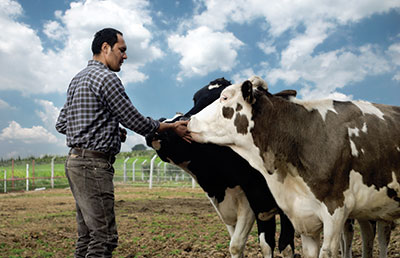FSA AGI Tests to Get Tougher Under New Tax Law?

Farm operations that sign up with FSA for ARC, PLC, CRP payments, etc. are subject to certain adjusted gross income (AGI) limitations both at the entity and individual level. The current farm bill limits farmers and their owners to an overall AGI limit of $900,000. Under previous law, individuals simply calculated their AGI based upon the number shown at the bottom of page 1 of Form 1040. AGI under these rules included the deduction for DPAD (Section 199).
The new tax law has eliminated DPAD and created a new Section 199A deduction (the 20% of farm income or 20% of cooperative distributions). In many cases, this deduction (for those farmers who sell solely to a cooperative) will result in a farmer have taxable income close to zero, however, their AGI may be over the FSA AGI limit. This is due to the Section 199A deduction not being part of the AGI calculation. Under old law, we had four sections to compute taxable income as follows:
- Total income, less
- Total adjustments to income, (AGI) less
- Total itemized deductions or standard deduction, less
- Personal exemptions.
Under the new law, we still have four sections, but they have changed to:
- Total income, less
- Total adjustments to income, (AGI) less
- Section 199A deduction, less
- Total itemized deductions or standard deduction.
Let’s see an example on how this may affect a farmer:
Farmer Steve operates as a Schedule F farmer and has gross farm revenue of $5 million to a cooperative and nets $1 million before the Section 199A deduction. He has about $25,000 of adjustments to income resulting in AGI of $975,000, however, his taxable income ends up being zero since 20% of $5 million is greater than his AGI (the Section 199A deduction is limited to taxable income less net capital gains). When Farmer Steve calculates his average AGI for FSA purposes, he finds out that his AGI is over $900,000 and he will not qualify for any ARC or PLC payments (This assumes the same fact pattern for three years since the FSA AGI calculation is based on a three-year average).
Also, regular farm corporations were allowed to deduct DPAD under the old law. Under the new law, they will not be able to deduct Section 199A (this is only for non C corporations), therefore, their tax liability may increase and also lose FSA payments. Let’s look at a quick example:
ABC Dairy Corporation normally had $15 million of gross sales, netted $1 million before receiving a DPAD deduction from their cooperative of $900,000. This resulted in net taxable income at the corporate level of $100,000. The tax liability would be slightly less than $25,000 and the corporation could keep up to $125,000 of FSA payments (before any sequestering adjustment). Under the new law, the corporation would have taxable income of $1 million and owe about $210,000 of corporate tax ($1 million times 21%) or an increase in tax of about $185,000. The corporation would also be over the FSA AGI limit and would not receive any ARC or PLC payments for the current crop year. The net result would be about $310,000 of extra taxes and lost FSA payments.
As you can see, the new tax law can reduce taxes in some cases, increase it in others and eliminate FSA payments for both. We will keep you posted.
Paul Neiffer is a certified public accountant and business advisor specializing in income taxation, accounting services, and succession planning for farmers and agribusiness processors. Paul is a principal with CliftonLarsonAllen in Walla Walla, Washington, as well as a regular speaker at national conferences and contributor at agweb.com. Raised on a farm in central Washington, he has been immersed in the ag industry his entire life, including the last 30 years professionally. Paul and his wife purchase an 180 acre ranch in 2016 and enjoy keeping it full of animals.

This seems incorrect. Individuals do not receive a 20% deduction of their GROSS sales but rather its 20% of their NET farm income. The coops themselves receive the 20% deduction reduced by the actual patronage paid out to patrons to reduce the coops income; however this no longer gets passed through to the individual patrons like the old DPAD did. Let’s pump the breaks and actually understand the law before we start blasting out information just to be first.